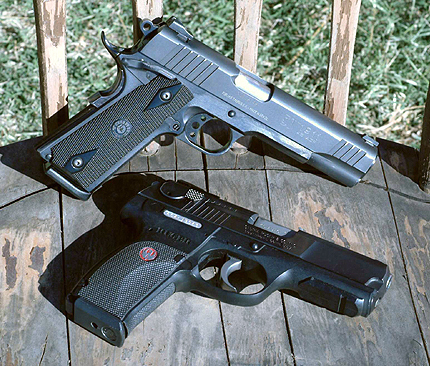
Handgun Review: Ruger P345 and Taurus PT1911
By
Aaron Brudenell
Itís not lost on me the timeliness of conducting this review shortly after the passing of Col. Jeff Cooper. For most of my time and interest spent on firearms, the .45 ACP was never a front burner priority for me. Only recently have I rediscovered the enjoyment of shooting the cartridge and some of the numerous firearms available in that caliber. Two of the newer ones are the subject of this review and they bear a number of similarities and notable differences that should make one of them an excellent choice for someone interested in trying out the .45 Auto for the first time. Die hard .45 ACP fans interested in a new gun may also find one or both of these suitable additions to their collection.

The article will focus on these two relatively new .45 ACP pistols. Note that the Ruger has the accessory rail.
To begin with, both guns are relatively new products from their respective manufacturers and in each case, I think their latest .45 is a solid step forward when compared to their other good offerings. Both pistols are short recoil operated and have an 8-round single stack magazine. Among the features included in both models are ambidextrous manual safety controls, thoroughly checkered grip surfaces, integral key lock safeties, and improved fixed sights when compared to other firearms offered from each manufacturer. One final similarity that will appeal to everyone is that each gun is more affordable than a number of similar products out on the market.
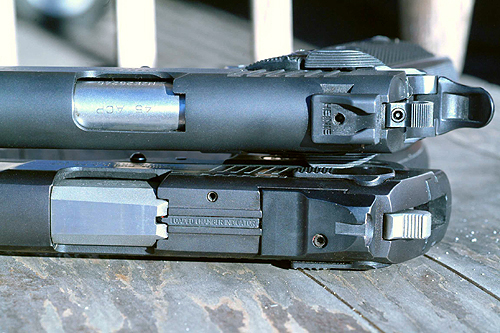
In this picture we can see the integral safety present on the Taurus 1911's hammer. The one on the Ruger can be seen when the thumb safety is engaged or in the downward position.
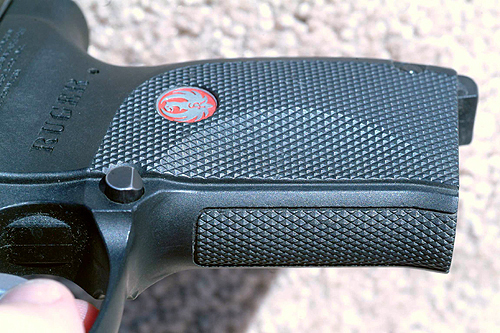
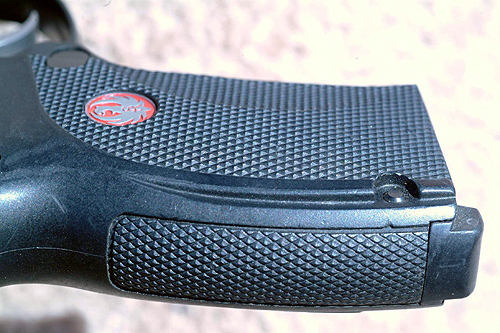
Like the Taurus, Ruger offers a secure grip on its 45-caliber P345 via checkering on the front and rear of the grip.
Speaking of buying on a budget, both guns were test fired with three different brands of 230-grain .45 ACP FMJ ammunition available at Wal-Mart. The better of two groups of each fired from approximately 18 yards (two hands unsupported) appears below. Both have acceptable accuracy with each although the Taurus is more consistent.
Ruger P345 Taurus PT1911
CCI Blazer (brass) 4.75" 3.75"
Remington UMC 5" 3"
Winchester USA 3.5" 4"
The Ruger P345 is a polymer framed double action pistol but is more than just an updated version of the P97 and improves on it in both cosmetics and ergonomics. Overall the pistol is slimmer and has fewer sharp edges than the P97 and fewer still than the P90. The slide mounted safety/decocker levers are well checkered and add minimal width to the slide. When the safety is engaged (down), a small hole in the right side reveals the integral key lock safety, and itís very easy to ignore if you donít care for such things. Two additional safety features not found on previous designs are the magazine safety and chamber loaded indicator.
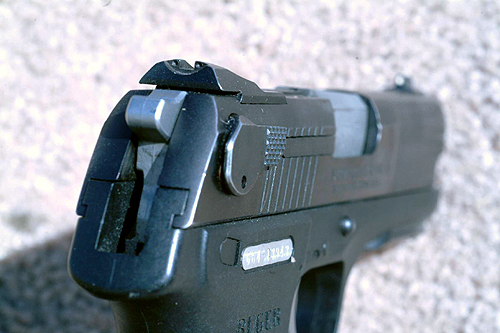
The Ruger's sights should offer quick pickup and still be snag free.
The loaded chamber indicator is both a visual indicator and one that can be felt on the top of the slide to indicate when a cartridge is chambered. One caveat to be aware of is that with shooting, the visible red areas of the indicator can become dirty and not be as visible. The magazine disconnect consists of a second firing pin block that must be engaged by the inserted magazine to allow full movement of the firing pin. Unlike most magazine safeties, this one does not disengage the remaining parts of the fire control system and you can otherwise fully cycle the action, trigger, hammer, and slide controls just as you would with a magazine inserted. Despite the added safeties that further punctuate the regulatory and litigious nature of our times most have been done in a very tasteful way that de-emphasizes their presence. Even the customary product-warning label is small in size and in an area of the gun thatís less prominent.
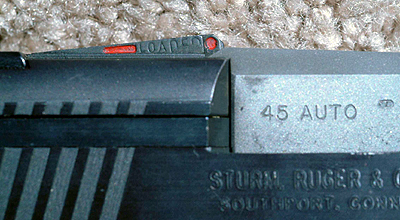
The Ruger's loaded chamber indicator can be both seen and felt.
The 8 round magazine is very similar to the previous Ruger 7 round magazines for the P90/P97 and are mutually compatible. In fact, if one desires to upgrade their 7 round magazines, all they need to do is replace the spring and plastic follower with equivalent P345 parts and the old magazine will function with an 8 round capacity. The magazine bodies are also different but only slightly and Iíve found no difference in function between the two. The newer magazine has a small crimp on each of the feed lips but oddly, the same placement and number of holes in the side to visualize loaded cartridges as the 7 round magazine. A magazine loaded with 7 rounds looks no different than one loaded with 8.
The Taurus PT1911 is essentially a modern 1911 pistol with a number of features that youíre likely to find on custom guns. These include front and back slide serrations, a full length guide rod, lowered ejection port, polished feed ramp, ambidextrous extended safety controls, improved profile grip safety, ring style hammer, and an adjustable skeletonized trigger. Even the checkering on the grip and under the trigger guard is fine and the grip panels are nicely textured and relatively thin (which I prefer). The sights are of the Heinie "Straight Eight" type consisting of two white dots that are vertically aligned in the proper sight picture.
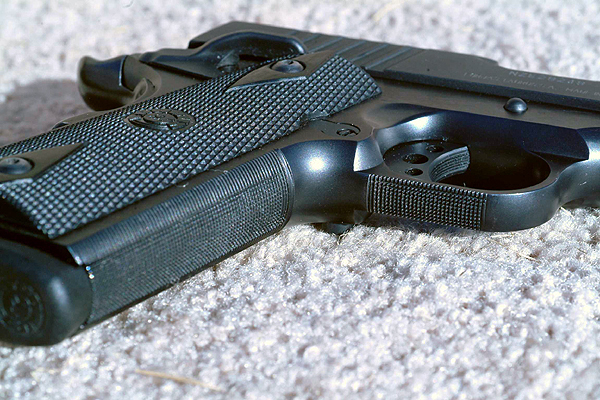
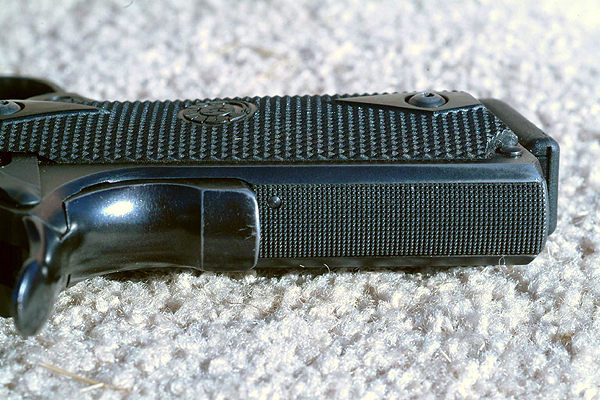
Checkering on the front and rear grip straps offer a firm hold. Note the checkering beneath the trigger guard.
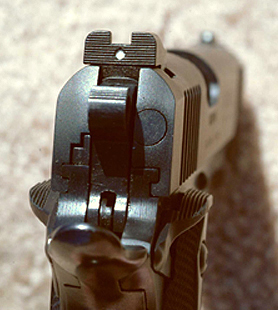
Here we see the Taurus' high-visibility rear sight, ambidextrous thumb safety and beavertail grip safety.
Unlike a number of the latest crop of 1911 pistols, the Taurus retains the original styled internal extractor, however, Iíve rarely had problems with this design. The PT1911 does not have as many extra safety features as the Ruger but there are two that werenít in the original John Browning design. There is a firing pin block plunger that is activated by the trigger pull, not unlike the Colt Series 80 design. There is also a key lock safety in the top of the hammer that will immobilize the hammer in either the up or down position when fully engaged. An incomplete turn of the safety key will not reliably immobilize the hammer so anyone using it should exercise the same level of caution as with any 1911 pistol. As far as I can tell, itís as good as or better than any other 1911 available in the same price range and has custom features that might double the cost of a similar gun if done by a professional gunsmith.

The Taurus 1911-pattern pistol uses a "Series 80" type internal firing pin safety system.
Both pistols are very serviceable and their main differences are design features and not reliability or accuracy. The Ruger offers a double action trigger option, a shorter (4.25") barrel, and a lighter polymer frame. The Taurus is heavier but has the longer (5") barrel and sight radius. Of the two, the practical accuracy advantage goes to the 1911 but I think most of that is due to the lower bore axis that helps the gun point better. Iím sure both would shoot the same if locked in a vise. The only failures I noted with either were magazine related. The factory magazines for the Taurus frequently failed to engage the slide stop after the last shot. Other standard 1911 magazines did not cause the same problem and were otherwise just as reliable. On one occasion, the Rugerís magazine safety failed to disengage and the magazine had to be removed and reseated. This was an original factory magazine for the P345 and in several hundred rounds since, no such failure occurred a second time. Iíd easily recommend either gun, especially if one does not mind the additional safety features and wants to get a good value.
Note: I would like to thank Mr. Brudenell for his work in composing this articleÖStephen A. Camp